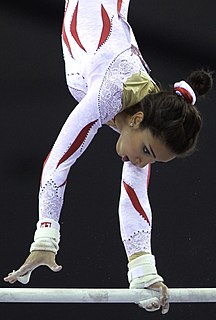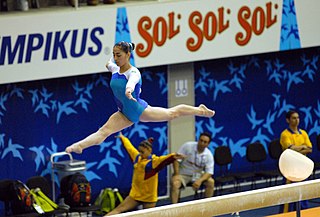
Rhythmic gymnastics is a sport in which individuals or groups of five manipulate one or two pieces of apparatus: rope, hoop, ball, clubs, ribbon and freehand. Rhythmic gymnastics is a sport that combines elements of ballet, gymnastics, dance, and apparatus manipulation. The victor is the participant who earns the most points, determined by a panel of judges, for leaps, balances, pirouettes (pivots), apparatus handling, and execution. There is no maximum number of points anymore but there was before the judges consider artistry, mastery, and execution. The choreography must cover the entire floor and contain a balance of jumps, leaps, pivots, balances and flexibility movements. Each movement involves a high degree of athletic skill and key movement. Physical abilities needed by a rhythmic gymnast include strength, power, flexibility, agility, dexterity, endurance and hand-eye coordination.

Trampolining or trampoline gymnastics is a recreational activity, acrobatic training tool as well as a competitive Olympic sport in which athletes perform acrobatics while bouncing on a trampoline. In competition, these can include simple jumps in the straight, pike, tuck, or straddle position to more complex combinations of forward or backward somersaults and twists. Scoring is based on the difficulty and on the total seconds spent in the air. Points are deducted for bad form and horizontal displacement from the center of the bed.

The uneven bars or asymmetric bars is an artistic gymnastics apparatus. It is made of a steel frame. The bars are made of fiberglass with wood coating, or less commonly wood. The English abbreviation for the event in gymnastics scoring is UB or AB, and the apparatus and event are often referred to simply as "bars". The bars are placed at different heights and widths, allowing the gymnast to transition from bar to bar. A gymnast usually adds white chalk to the hands so that they can grip the bar better.
Artistic gymnastics is a discipline of gymnastics in which athletes perform short routines on different apparatuses, with less time for vaulting. The sport is governed by the Fédération Internationale de Gymnastique (FIG), which designs the code of points and regulates all aspects of international elite competition. Within individual countries, gymnastics is regulated by national federations, such as Gymnastics Canada, British Gymnastics, and USA Gymnastics. Artistic gymnastics is a popular spectator sport at many competitions, including the Summer Olympic Games.
Annika Louise Reeder is a retired British artistic gymnast. She was the first gymnast from Great Britain to compete in two Olympic Games, in 1996 and 2000.

Oksana Omelianchik is a retired Soviet gymnast and the all-around gold medalist of the 1985 World Championships. Omelianchik was most known for her enthusiastic showmanship, difficulty and originality, including pioneering back-to-back tumbling.

Valeri Viktorovich Liukin is a Russian-American retired artistic gymnast turned gymnastics coach. As a competitor for the former Soviet Union, Liukin was the 1988 Olympic champion in the team competition and individually on the horizontal bar, and Olympic silver medalist in the all-around and the parallel bars.

Louis Antoine Smith, MBE is a retired British artistic gymnast.
The Rhythmic Gymnastics World Championships are the world championships for the sport of rhythmic gymnastics. The tournament is promoted and organized by the Fédération Internationale de Gymnastique (FIG). It is one of the three tournaments in rhythmic gymnastics officially organized by FIG, as well as the Rhythmic Gymnastics World Cup and the gymnastics competitions at the Olympic Games. The first edition of the World Championships was held in 1963, a time when the sport was known as modern gymnastics. The current program of the World Championships contemplates both individual and group performances. In even non-Olympic years and the year before the Olympics, a team event is also contested. Two events are not competed at the World Championships anymore: individual rope and free hands.

Ivan Ivankov is a Belarusian artistic gymnast. The 1994 and 1997 all-around World Champion and the 1994 and 1996 all-around European Champion, Ivankov has competed for over a decade on the international circuit. Despite his numerous achievements at the World Championships, Europeans and other events, Ivankov has suffered a string of misfortunes at the Olympics, and has never won an Olympic medal.
Melanie Roberts is a retired British gymnast, born on 13 May 1988 in Saltney, Flintshire, Wales.
Anamaria Tămârjan is a Romanian artistic gymnast. She is a bronze Olympic medalist and a gold European medalist with the team. Individually, she is a European silver medalist on balance beam and a bronze medalist on floor. Her favorite events are the floor and the balance beam.

Ksenia Dmitrievna Afanasyeva is a retired Russian artistic gymnast who competed at the 2008 and 2012 Summer Olympics. She is the 2011 world champion on floor exercise, the 2013 and 2015 European floor champion, and the 2013 Universiade vault and floor champion. Widely regarded as one of the most original and artistic gymnasts of all time, she retired from elite gymnastics in July 2016 due to kidney disease, a month away from the 2016 Summer Olympics, for which she was the Russian team's first alternate.
Izabela Daniela Lăcătuş is a retired Romanian artistic and aerobic gymnast. She was an alternate to the artistic gymnastics team at the 1992 Olympics. After retiring from artistic gymnastics she had a career in aerobic gymnastics, winning 16 world and continental medals including the 2000 individual world title.
Yekaterina Vladimirovna Lobaznyuk is a former Olympic gymnast who competed for Russia in the 2000 Olympic Games in Sydney, Australia, winning three medals. Her name is sometimes written Ekaterina Lobazniouk.

Elissa Downie is an artistic gymnast who represents Great Britain. She is the All-around 2017 European gymnastics champion, the first gymnast to win a major all-around title for Great Britain.
The Pan American Gymnastics Union organizes Pan American Gymnastics Championships in different disciplines of gymnastics: men's and women's artistic gymnastics, rhythmic gymnastics, acrobatic gymnastics, trampoline and tumbling, as well as aerobic gymnastics. The Pan American Gymnastics Championships are considered by the International Gymnastics Federation to be the official continental championships for the Americas. The entity also recognizes the South American Gymnastics Championships as the official continental championships for South America. Pan American Championships have also been organized for the sport of aesthetic group gymnastics.
Marie Skammelsen is a retired Danish artistic gymnast. A Danish national team member since 2010, joining at an unprecedented age of nine, she has amassed several medals at the Northern European Gymnastics Championships as a junior, including her all-around title at the 2016 event. In June 2016, she made a fourth place finish in the vault final at the 2016 European Artistic Gymnastics Championships in Bern, Switzerland.











